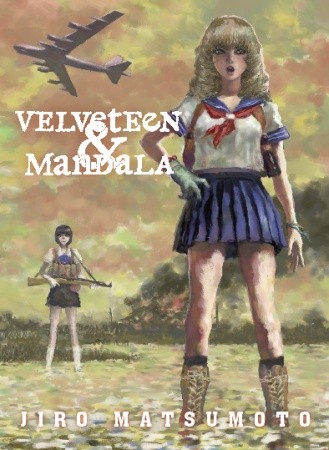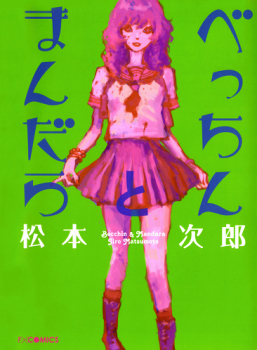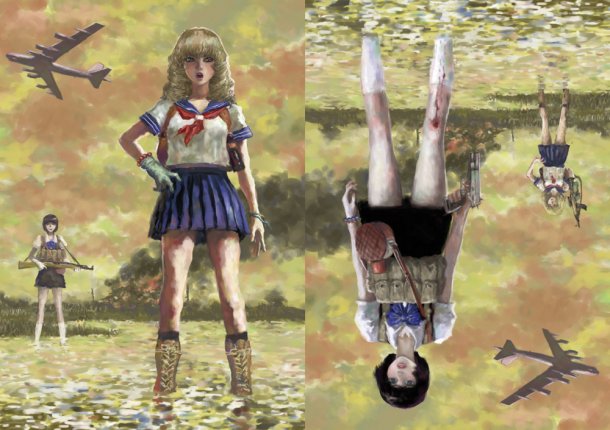
Logo handmade by Bannister
Column by Scott Green

Manga Spotlight: Velveteen and Mandala
By Jiro Matsumoto
Released by Vertical, Inc.
The world of Velveteen & Mandala isn't a landscape of sand blasted wastes populated by cannibalistic pro-wrestlers. There's municipal government. Planes and trucks are still running. However, in that matters seem real cooked, the label "post apocalyptic" seems real appropriate. That eggs is cracked and fried... you're not getting it back in the shell.
Under those circumstances, runaway teen schoolgirl Velveteen lives in a tank, down by the river. So, she's not washing, eating spoiled food, and hanging out with the possibly even more cracked than herself stray schoolgirl Mandala, and taking work from the Superintendent of the Tama Riverside - a guy who walks around sans pants, drawing extreme, misogynistic scrawls in his research journal and aiming his rifle at imps that he compares to "the Kodamas in Princess Mononoke," but which look to him like the rabbits and frogs from the Choju-jinbutsu-giga playing Nintendo DS, assaulting each other with baseball bats, and frolicking with Evangelion's Rei Ayanami.
Velveteen's swamp home collects lost and discarded stuff, like herself. And, among the washed-up, detritus that Velveteen and Mandala take work cleaning up are the animated souls of the dead, dubbed "deadizens." Most of these half broken shamblers don't seem to know they're dead, so some attack, while others get gunned down as they discuss their evening plans, chide the girls for playing hooky, pitch a baseball, or huddle in the marsh grass for a job interview. There's even a shooting gallery spread of pseudo-celebrities taking one between the eyes.
If he hadn't passed away in 2010, and if it weren't incredibly tacky to say it, I'd trumpet Velveteen & Mandala as "Satoshi Kon of the Dead." However, given the reality of circumstances, with notable discomfort, I just have to point out that it is still an apt description.
With the impression reinforced by its concise, one volume length, Velveteen & Mandala would frickin kill as a movie. That's not to say I'd prefer it as a movie, or that it would be better as one, but that movies that are creative, especially creative in the way that they work
with human perception, find cult audiences, especially if they're also wildly taste affronting.
Meanwhile, in North America at least, manga possessing qualities qualifying for that sort of buzz bull's eye in the movie realm are apt to be caught in a cycle of disinterestest. Why would an adult audience track manga when so little is of interest to them? (Or, in reality, was crowded to the margins in the boom years). Why license/translate for an audience that largely ignores manga?
That trouble getting the potentially interested audience to pay attention to the manga is probably the reason why the one volume Velveteen and Mandala is the first of author Jiro Matsumoto's work to be licensed for English translation.
Matsumoto's internationally best known work, due to its length and live action adaptation, is Freesia, which ran 12 volumes after helping to kick off the Japanese run of alt anthology Ikki (a sample of Ikki's other series digitally serialized on Sigikki. Set in the midst of a prolong economic recession during which revenge killing is legalized, Freesia followed schizophrenia suffering gun for hire who kills killers. Physically, it's not a clean business. He uses a brick in the first chapter. Psychologically, it's not clean either, as the lead's persona begins to become entangled with his targets'.
Matsumoto's voluminous body of shorter volume or two long work includes the likes of Uncivilized Planet - kindof 1984 meets Leiji Matsumoto; Tropical Citron - sex, drug, beatings and Vietnam distracting a would be photographer and Wendy - an early abduction and anarchy, bent riff on Peter Pan, not to mention plenty of short stories.
Velveteen & Mandala works from Matsumoto's approach to depicting profoundly disturbed persons/people situated in profoundly disturbed worlds. Social and mental breakdowns coincide with each other.... though, well, "breakdown" implies that it's not already broken, where this is more akin to a structural failure waiting to topple. The preview of subjects includes rebels, and criminals and zombie fighting school girls... he actually seems to have developed something of a fixation with, or at least an interest in the absurd juxtaposition of girls in skirted uniforms and violent work, such anti-prostitution SWAT teams in manga short story Parlor31 or girl shaped giant war mecha in "Schoolgirl Soldier."
There are through lines connecting Matsumoto's troubled cases. For one thing, the subjects of Matsumoto's manga are violent, and/or in another way antisocial (Velveteen and Mandala isn't the first Matsumoto work to prominently feature arson). His work isn't quite as diverse as that of the potently shocking film makers that at least I'm inclined to peg him as a comparison to, but while his works have not evolved in the same directions, it is as interesting as your Takashi Miike's and Sion Sono's. Presumably he recognizes that his readers are fascinated by dangerous people. His work certainly feeds the human biological wiring that predisposes us to be fascinated by predators and other threatening individuals. But, it's not a simply study of red flag individuals. There are interesting broader implications that just gawking at wolves in human closes.
In Jiro Matsumoto's Matsumoto-verse, society isn't some clean surface that the mentally disordered track mud and distinct bloody marks onto. In Velveteen and Mandala, most of the non-mentally-disordered people are zombies, so it's not like this particular manga offers a conventional social norm to measure our leads against, but still, amongst the episodic situations is one in which a bullied character gets gagged with a lacy handkerchief and spiked through the hand. Some relatively functional human being is flying those planes dropping the bombs on Tokyo. Humanity is pretty brutal species... where in which individuals are given to probing each other with flesh and steel... one that's gotten a bit charred in this manga. The wider view of Matsumoto's manga is that the Velveteens and Mandalas are mentally a bit skewed, but not the exceptional bad actors.
A characteristic that distinguishes Matsumoto's manga is how that messiness is put on display in ways that are graphic and at least borderline gratuitous. It's safe to say, sex violence and sexual violence are hallmarks of Matsumoto's manga.
Matsumoto sets his view on trash strewn, overgrown lots, alleys and dark rooms It's the places where things really bad, or at least unmeant to be seen, occur. It's manga that watches the things that human do do, but which we'd rather not even think about.
In stark contrast to something like Gantz's 3D modeled exploitation thrills, the further than fucked up dysfunctional world of Velveteen and Mandala throws the basic survive, kill, eat, reproduce urges into full turn-off mode. There are scenes in this manga that purposefully moon shot past the mark in crossing the bounds of good taste. For example, there is a lot of spoiled fools here. A scene of simultaneous vomiting and diarrhea has been noted, and that non-story spoiler bit of transgression has little on the Reese's Peanut Butter Cups of compound stomach turning bad taste that it leads into.
Any manga reader is apt to hit plenty of examples where rape was framed in a way that was supposed to be kinky and killing was supposed to be exciting. While of Jiro Matsumoto's works tend not to be quite as bowelly as Velveteen and Mandala, he does make a habit of shitting on the notion of "useful" violence, sexual and otherwise. Which isn't to say he's humorless. While he knows it's titillating territory, he's not Michael Haneke chiding the audience. And, while expression is still too stylized to call verite, you don't get an airbrushed, aestheticzed version of sex and violence in Matsumoto's manga. He doesn't dehumanize (except for when he intentionally does) and doesn't stage it for the turn-on. People on the page don't fuck or die cleanly for the sake of the reader.
The result is manga that is routinely obscene, but not pornographically so. Voyeurism is one thing, but you probably wouldn't really want to watch your neighbors having sex. And, you definitely don't want to watch them beating or killing each other. At its most mild, it's all a bit icky in Matsumoto manga.
This carnality works as a set up for the second reason why Matsumoto's works aren't just about the people you'd like to see separated from sharp objects. Pre-homo-sapiens drives towards sex and violence are a big part of the equation, but that's not the extent of it. There's also a lot of thinking going on, and attempt to get a head around the consequences of that sex and violence. Wrapped in with the reproduction and survival, humans are given to looking for patterns and explanations. Ultimately, that might be where matters really get messed up.
Velveteen and Mandala has to contend with the issues of its heroines.
It might be a yin-yang relationship more than a pure delineation, but there are generalities to be made.
Velveteen acts out. There's the previously mentioned suggestions of running away and arson for a couple of examples.
Mandala is stuck in her own head, tracing some shorted neural circuits. She has her weird, relationship with Velveteen that doesn't fall too far outside the lines of an understandable bickering friends dynamic. At one point, she asks the Superintendent if they'll be supplied bananas during their zombie processing work. However, beyond these, coherent relationship with others aren't exactly the norm for Mandala. More typically, her want is to say things that barely make sense to anyone other than herself. She doesn't sing, but if she did, she'd be the person singing the songs that get stuck in your head. Ever think of a comeback to an insult long after the fact, or some idiotic justification for something you said or did, only to have that thought rattling around your head all day? Mandala's conversational MO is to vocalize those thoughts on a repeating loop. There's her "tape recorder" verbal tick, and sequences like the memorable one in which she spends most of the day repeating "I'm smarter than you Velveteen. So smart my parents were called in the day after my grammar school IQ test."
And in the Matsumoto tradition, those cracked leads are wed to the whole mess of war and zombie plague. In the context of the manga, bombing planes dropping explosives and to-be-re-animated bodies have become the norm, but even if throwing on gas masks and huddling in bomb shelters has become routine, carrying around an automatic weapon is a clear sign that your problems are big ones.
Along with survive/reproduced, humans are given to finding patterns to explain situations, and open sours like zombie invasions call for an examination. When it comes to finding rationale in this mess, Matsumoto puts the reader on something like a level playing field with the subjects. Troubled Velveteen and Mandala are certainly unreliable point of view characters, and beyond that, there's the absence of credible adult windows. With a few lynchpin exceptions, the authority figures here that aren't overtly crazed functionally speak in Peanuts "wah wah" nonsense.
Japan is an island nation, issues with available land, being situated in ring of the fire, and meteorological patterns that prompted the evolution of more of a tradition of cremating than burring the dead. As such, you get undead stories about people thrown down wells, drowned in water or heaped on a battlefield. Velveteen and Mandala's deadizens sort of everyone rises from the grave isn't particularly native. On the other hand, in an age of global pop media, everyone knows that when the decaying folks start lurching towards you, it's time to aim for the head.
That Romero infused apocalypse is appropriate for the mental circuits that the manga draws. There's plenty of pop culture evoked here, and it's not just glib allusions for the sake of having audience appreciate shared references.
At least for people like the subjects of this manga, you have an end of days, and you don't have the Bible or another religious structure to explain it. Instead, what you do have is RPG menu systems, Tomino anime, and other pop culture rattling around. Processing this apocalypse, it doesn't look like Sodom and Gomorrah or god's wrath, it looks like Hayao Miyazaki's Nausicaa or Hideaki Anno dropping mass produced Evas on us. At least for the higher functioning character here's, it's not that they think God Warriors are raining down the Seven Days of Fire on the world, it's that that is show they frame and understand their circumstances. A couple characters are Jiro Matsumoto readers and points of this look like Jiro Matsumoto manga to them.
Anime and manga are great media for these sort of stories where characters become mentally unmoored such that lines between what's going on in their heads and what's going on in concrete reality become blurred. It's pretty clear that the riverside superintendant is not seeing imps chasing Evangelion character in the reality of the manga. Especially given how manga can put the delusions and reality on the same visual plane other incidents the mind may have derailed from the tracks of reality aren't quite so clear.
Finally, as crazy as the manga is, the scale and the domain of the Velveteen and Mandala make a satisfying sort of sense.
Satoshi Kon's movies tended to deal with glacial block of culture. Perfect Blue had otaku-bait idols and iffy thrillers, but Millennium Actress rode with the cinema of the 20th century, Paranoia Agent with a Hello Kitty like mascot and Paprika with legacy rich cultural landmarks. In contrast, the flotsam picked up by Velveteen and Mandala tends to be geek crap. It's the sort that spins-off net memes, which is pretty appropriate for the manga's mental pathways.
At the same time, the two girls, one volume span of Velveteen & Mandala grows its wild little garden rather than engage in a big high, concept clear cutting of the idea. I don't want to knock Inception down a peg, but one thing that always bothered me about the Nolan movie was that I felt it exhausts a human perception story field. With its sprawling expanses, for a while, Incept is going to be THE dream movie. For a while, you will not be able to do another movie about dreams without it being post-Inception. I like that Velveteen & Mandala isn't so big that it is going to be THE mind fuck zombie manga. It's this marvelous, gross, little apocalyptic curiosity. Something to think about, re-read and re-consider the patterns, a great zombie work that sticks around in your head without looming like a mausoleum.


